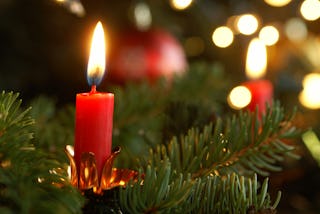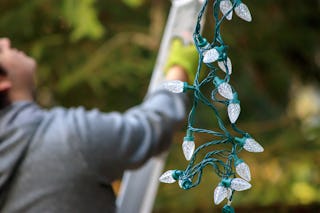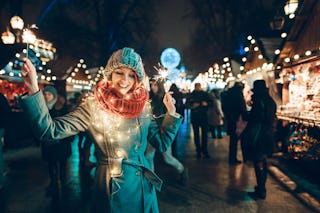
Christmas lights are often the first decorations to go up and the last to come down around the holiday season. No matter where you go, you see them everywhere – in living rooms, on the roofs of houses, at office buildings, and lining city streets.
After all, what is Christmas without Christmas lights?
But we probably don’t put much thought into where our lights came from and how they got to where they are today.

The History of Christmas Lights
Like many of our other Christmas traditions, Christmas lights started long ago in Germany. Traditionally, candles were used to light up Christmas trees, attached to branches with pins or melted wax. And in the 17th Century, European Christians put burning candles in the windows of their houses to show others that they could worship there. Eventually, that tradition made its way over to America and other parts of the world.
But as I’m sure you can imagine, candles were a huge fire hazard. Families could only keep them lit for short periods of time (often increments of half an hour or less) and they kept a bucket of water nearby at all times should fires arise, which they often did.

Fun fact: Collectively, insurance companies decided to stop paying for fires caused by Christmas frees, stating in contracts that they were a “knowing risk.”
When it comes down to it, Christmas string lights were just a happy accident.
In 1880, Thomas Edison had already invented the incandescent light bulb and was looking for a way to advertise it. So he hung up lights on the outside of his laboratory to show them off to passersby.
A couple of years later, one of his employees realized that the lights could be used to solve the problem of fires caused by candles on Christmas trees. So he strung 80 red, white, and blue Christmas lights around a Christmas tree and called local newspapers to cover the brilliant idea. Understandably, the idea took off, especially once several Presidents started lighting trees at the White House.
General Electric bought the patent from Edison and started selling Christmas tree lights to the public. But Christmas lights were very expensive, especially since they required installation and electricians were few and far between at the time.

Department stores even suggested that families rent the lights rather than buy them! Though we still use incandescent bulbs in many applications, over time, companies were able to make Christmas lights much safer and more affordable.
Today, the most popular Christmas lights are C7 and C9 lights, which are the small, strawberry-shaped lights that you may think of when you think of the holidays. But now they come in all kinds of colors, shapes (even flamingos and beer cans!), and sizes, while many flash and play music.
If you’re looking to save energy, LED lights are also a great option. They use 10% of the electricity of incandescent bulbs and, also, reduce the risk of fire.
Fun fact: Approximately 150 million light sets are sold in America each year.

Outdoor Christmas Lights
But, of course, we don’t just use Christmas lights to decorate our trees; they’re also used outdoors! Decorating the home or yard is a modern tradition in the days leading up to Christmas.
There are a ton of creative ways to use Christmas lights in your yard, from lighting up Christmas-themed shapes (Santa Clause, reindeer, snowmen) to adding lights to bushes, trees, fences, and more.
Net lights are also a huge time-saver! Introduced in the 2000s, net lights have bulbs that are spaced out in a perfect grid, or net. Designed for outdoor use, they can be used to decorate a relatively large object (like a shrub or tree) in a short amount of time.
And have you ever driven through a neighborhood just to see a Christmas light show? These stunning light displays are synced with music (often played on a dedicated radio station channel) and show off themes from Star Wars to Metallica, the traditional nativity scene to vintage/retro themes.
This is where the idea for the Great Christmas Light Fight show on ABC came from. Families with over-the-top light display compete to win a $50,000 prize. This definitely goes to show how much we all love Christmas lights!
Fun fact: The world’s largest Christmas light display used nearly 1.2 million LED bulbs.

Christmas Light Traditions
Above all, Christmas lights have really become part of the Christmas tradition. Many neighborhoods have light and decoration competitions, bringing friends and families together each year.
And lights define customs in cities across the United States as well!
In Kansas City, MO, office buildings and houses use clear, C7 or C9 incandescent bulbs to outline their roofs, creating a Christmas village feel across the entire town.
Florida and other coastal areas decorate palm trees instead of traditional furs.
At the Ford Fiesta de Las Luminarias in San Antonio, people line the riverbanks with glowing candles in sand-filled bags, matching the surrounding Christmas lights.
And in Arizona, you can literally drive from one end of the state to the other following a trail of lights.
Fun fact: One of the oddest Christmas light traditions is the tumbleweed tree in Chandler, Arizona. There, they assemble a gigantic tree made out of tumbleweeds and light it for the holidays.